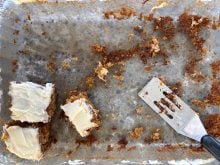November is when our thoughts move indoors. We see the corners in our homes that need a facelift or the not-quite-finished decorating projects we need to complete.
There seems to be a push to get things fixed before the busy Christmas season of social activities and visitors.
I had good intentions of looking for some wallpaper for my kitchen since spring, but the outdoors got priority.
Recently, I spent about two hours looking through wallpaper books searching for the idea I had in my head. I have a blue and white kitchen with several Delph blue and white type china pots that hold plants on my windowsill.
Read Also

VIDEO: Bittersweet harvest for this family farmhand
Bruce Burnett helps his brother harvest wheat and canola for the last time on the family farm in Manitoba where they both grew up.
I thought I would like something with a Dutch tile effect. I wasn’t able to find anything, so I had to open my mind to alternatives.
After picking several possibilities, I borrowed the sample books to see how they looked in my kitchen in daylight and in the evening.
Through this process I realized the design principles of my long-ago colour and design classes were resurfacing.
- The design and colour of wall coverings can affect the character and mood of a room. I realized I wanted just a touch of warm colour to accent and brighten my blue and white kitchen. I thought something with apples or roses might work.
- Large scale and bright or dark colours appear to bring walls and ceilings closer, making a room feel smaller. Large overall patterns lose their effectiveness in the small space between the countertop and cupboards.
- Small scale designs in light colours seem to push back the walls and make a room more spacious. Some of the small patterns just looked too busy for the small area between the countertop and cupboards, while other small patterns seemed to just disappear. The kitchen is spacious with lots of light, so it isn’t a priority to create a feeling of more space.
- Vertical lines are formal and add height.
I didn’t want a formal feeling and with high ceilings and cupboards to the ceiling, I didn’t want to emphasize the vertical lines.
- Horizontal lines are restful and reduce height. I wanted a friendly, relaxed atmosphere and a horizontal line would visually reduce the tall cupboards.
- Curved lines are graceful and soft. This would add to the relaxed atmosphere. Something with a floral would give relaxed lines.
- Small scale geometrics, all-over florals and colourful plaid wall-covering patterns can unify a room that has “broken-up” wall areas.
I wanted a unity of colour and theme, especially the blue and white, so any paper that had an off-white or cream background did not work. The background had to be white to match the cupboards.
Surprisingly, after I went through this process, the paper that I think I am going to get is a wide border that will just fit in the space between the counter and cupboards.
It has different shaped Delph blue type vases with bouquets of flowers. This continues the look of the windowsill. As well, the soft curved lines of the vases and flowers add to the relaxed atmosphere.
Three of the flower bouquets – roses, violets and bachelor buttons – are three of my favourite flowers. The touch of rose-coloured tones in the flowers adds just the warm accent I was looking for.
The horizontal line visually reduces the height, but the white background gives the feeling of looking out a window, which adds to the spacious feeling.
Working through the design principles gave me a decorating touch I like and reasons for selecting a paper I initially overlooked.
Each year the home economists and staff of the Atco Gas Blue Flame Kitchen search for recipes to use during the holiday season and compile them into a holiday cookbook. The 2001 Holiday Cookbook has just been released.
Many of the recipes are time-honoured family favourites. There are also new recipes and new food ideas.
Each recipe is tested. The menus have been planned with time, flavours and practicality in mind.
Holiday decorating ideas and helpful information such as carving a ham, planning a wine and cheese party and cooking a turkey on a natural gas barbecue complete this holiday cookbook.
Copies can be ordered from the toll-free order desk at 800-840-3393 or visit the Atco Gas website at www.atcogas.com. The books are $5 plus $2 for postage and handling.
TEAM Resources will be giving away two of them in December. To be eligible to win, we invite you to send us your favourite Christmas recipe or craft ideas. We will share these with readers during December. From all of the letters and e-mails received we will make draws for two of the cookbooks.
The following information about selecting, buying and serving hams is from the cookbook. A reader asked me recently if all hams should be cooked before serving. This explains it.
Bone-in whole ham is the cured, smoked and fully cooked whole leg of pork. This ham contains the whole muscle and may be cut and sold as smaller shank or butt portions. The rind may be partially or completely removed. All of these hams are ready-to-serve but can also be heated and glazed.
Processed ham products, including old fashioned black forest, honey and toupie style, are examples of boneless hams. Some varieties contain the whole muscle but have the bone removed. Others are formed from fresh boneless ham meat that is pressed into netting, casing or moulds to give the characteristic ham shape.
The flavour and quality of hams vary from brand to brand. Boneless hams are ready-to-serve and easy to carve.
- Bone-in-hams provide two to three servings per pound (500 grams).
- Boneless hams provide three to four servings per pound (500 g).
When buying ham, make sure there is a good proportion of lean meat to fat. The outer fat covering should be firm and white. The amount of bone in relation to meat should be small.
Unless otherwise specified by a best-before date, refrigerate ham in its original wrapping for up to seven days. If vacuum packaged, check package for best-before date.
Leftover cooked ham should be refrigerated within two hours of cooking. Keep refrigerated for up to four days.
For best quality, do not freeze ham either before or after cooking, because freezing temperatures result in changes in flavour and texture. If necessary to freeze ham, wrap it in moisture-proof wrapping and store in freezer for one to two months. Thaw in refrigerator before using. Plan to use thawed ham in cooked dishes. Do not refreeze.
Follow recipe directions for baking a ham or use the following general method. If desired, remove rind from ham before cooking. Without cutting into the meat, score fat in a crisscross fashion to make diamonds.
Place ham, fat side up, in a shallow roasting pan. Insert a meat thermometer into the centre of the thickest part of the ham without touching bone. Do not add water or cover ham.
Bake at 325 F (160 C) for 12-15 minutes per pound (500 g) or until a meat thermometer reads 140 F (60 C).
If ham is to be glazed, apply glaze during the last 30 minutes of cooking. Transfer cooked ham to a warm platter. Let stand for 10-15 minutes before carving.
Source: Atco Gas Blue Flame Kitchen Holiday Cookbook 2001.
















